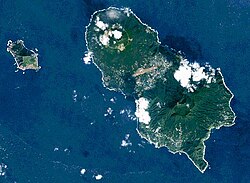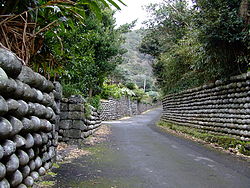Hachijō-jima
Hachijō-jima (八丈島) is a volcanic Japanese island that is in the Philippine Sea and the Pacific Ocean. This island is also part of Tokyo.[1][2][3] Several types of animals live on this island.[4]
| Geography | |
|---|---|
| Location | Izu Islands |
| Coordinates | 33°06′34″N 139°47′29″E / 33.10944°N 139.79139°E |
| Archipelago | Izu Islands |
| Area | 62.52 km2 (24.14 sq mi) |
| Length | 14 km (8.7 mi) |
| Width | 7.5 km (4.7 mi) |
| Coastline | 58.91 km (36.60 mi) |
| Elevation | 854.3 m (2,803 ft) |
| Country | |
Japan | |
| Demographics | |
| Population | 7522 |
Transportation
People go to Hachijō-jima by airplane or by a ferry. In 2010 a pedestrian ferry would leave Tōkyō once every day at 10:30 pm, and then it would get to at Hachijō-jima at 8:50 am the next day. Air travel to Hachijojima Airport takes around 45 minutes from Tōkyō International Airport (Haneda).[5] In the year 2000, there were three metropolitan roads on Hachijō-jima: 215 (formally, 東京都道215号八丈循環線),[6][7] 216 (都道216号神湊八重根港線, 8.3 km),[6][8] and 217 (東京都道217号汐間洞輪沢港線).[6]
Language
The Hachijō language is the most different form of Japanese; it is the only surviving descendant of Eastern Old Japanese.[9] The number of people who speak this language is not known. It is on UNESCO's list of endangered languages,[10] It may be gone by the year 2050.[11]
History
People have lived on this island since 14,000 b.c.e.[12]
Hachijō-jima Media
Hachijō-jima (right) and Hachijō-kojima (left)
Kaiten Type 1 suicide submarine used during World War II
References
- ↑ "Take a trip to Hachijojima and enjoy the island's springtime ocean breeze and nature |TAMASHIMA.tokyo". TAMASHIMA.tokyo. Retrieved 2021-04-01.[dead link]
- ↑ "The Treasure Islands of Tokyo | Travel". Metropolis Japan. 2021-03-03. Retrieved 2021-03-28.
- ↑ "Adjacent waters of Hachijo Island | Ecologically or Biologically Significant Marine Areas [MOE]". www.env.go.jp. Retrieved 2021-03-28.
- ↑ "Wildlife of Hachijojima Island|Natural parks in Tokyo". www.kankyo.metro.tokyo.lg.jp. Retrieved 2021-03-31.
- ↑ "Hachijo-jima – Floral Paradise". Hiragana Times (Japan). Feb 2010. http://www.hiraganatimes.com/past-articles/travel/702/. Retrieved 13 April 2017.
- ↑ 6.0 6.1 6.2 平成17年度道路交通センサス 一般交通量調査 休日調査表 Archived 2013-01-24 at the Wayback Machine (PDF), 2000; page 6. Retrieved 16 March 2018.
- ↑ 八丈島 II Archived 2018-03-16 at the Wayback Machine, Geospatial Information Authority of Japan. Retrieved 16 March 2018.
- ↑ 再評価結果(平成18年度事業継続箇所 一般都道神湊八重根港線(大 Archived 2013-02-02 at the Wayback Machine (PDF), Ministry of Land, Infrastructure, Transport and Tourism. Retrieved 16 March 2018.
- ↑ Shibatani, Masayoshi (1990). The Languages of Japan. Cambridge: Cambridge University Press. p. 207. ISBN 978-0-521-36918-3.
- ↑ "UNESCO Interactive Atlas of the World's Languages in Danger - Hachijō". UNESCO. Archived from the original on 8 March 2018. Retrieved 8 March 2018.
- ↑ Heinrich, Patrick (2012). The Making of Monolingual Japan: Language Ideology and Japanese Modernity. Bristol: Multilingual Matters. p. 139. ISBN 978-1-84769-659-5.
- ↑ "History of Hachijojima Island|Natural parks in Tokyo". www.kankyo.metro.tokyo.lg.jp. Retrieved 2021-03-31.
Other websites
| Wikimedia Commons has media related to Lua error in Module:Commons_link at line 62: attempt to index field 'wikibase' (a nil value).. |
- Hachijojima – Japan Meteorological Agency (in Japanese)
- "Hachijojima: National catalogue of the active volcanoes in Japan" (PDF). Japan Meteorological Agency.
- Hachijo Jima Volcano Group – Geological Survey of Japan
- Hachijojima: Global Volcanism Program – Smithsonian Institution








